Introduction
The discoveries of crude drugs are sometimes based on the alternative medicine developed by indigenous people. Faloak is a stem bark from the faloak tree (Sterculia quadrifida R.Br) used by people in East Nusa Tenggara Indonesia, as traditional medicine (Figure 1). Locals people believe faloak stems bark (FSB) can cure liver dysfunction, cancer, gastroenteritis, anti-diabetic, and fatigue recovery1. Extract of faloak stems bark (FSB) contains bioactive compounds of alkaloids, flavonoids, phenols, and terpenoids 1. Exploration of FSB is necessary to know the bioactive compounds and study the extract’s biological activity.
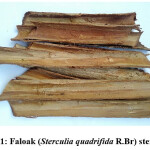 |
Figure 1: Faloak (Sterculia quadrifida R.Br) stem bark |
Selecting a suitable extraction method is crucial in isolating bioactive compounds in plant materials. Conventional extractions were applied for years to obtain a plant bioactive compound extract. However, some conventional extractions are inefficient methods.3 Nowadays, microwave-assisted extraction, a green technology extraction, offers many advantages, especially thermo-sensitive compound extraction.2 Isolating of bioactive compounds from plant matrix using MAE is related to some parameters such as the chemical nature of the bioactive compounds and the plant matrix, time, ratio of ethanol and water, and temperature.4 Ethanol, a green solvent with low toxicity compared to methanol, evaporates quickly and is commonly used in pharmaceutical industries. The ratio of water and ethanol needs to be optimized to obtain maximum bioactive compounds in the plant.5 Water and ethanol are suitable for plant extraction using MAE, which has proved efficient for the phenolic compounds’ extraction from plants.6-10 In extraction involving a microwave, water is essential since entrapped water in the plant matrix can interact with the microwave, causing cell rupture and releasing targeted compounds into the solvent.11 The temperature of extraction is necessary to be optimized. High temperature can reduce the viscosity and surface tension which solvent penetrates better into the plant matrix cell.5 However, the degradation of bioactive compounds occurs at high temperatures. Extraction yields can be increased by extending the extraction time. However, a longer extraction time can lead to the degradation of heat-sensitive compounds.12 The extraction time using MAE is generally less than 30 min.13
Phenolic compounds contain many hydroxyl groups, which can be conjugated with sugars, acids, or alkyl groups. Therefore, one plant can have very diverse phenolics. Developing one extraction condition to obtain all the phenolic compounds is difficult. In this study, the optimal temperature and time of MAE for isolating the bioactive compound present in the FSB should be determined as to how those factors affect the phenol and flavonoid content of the extract. Moreover, a powerful analytical technique, HRMS, was used to profile the phytochemicals of the FSB extract.
Materials and Methods
Materials
Stems bark of faloak (Sterculia quadrifida R. Br ) was obtained from Kupang province of East Nusa Tenggara, Indonesia. All the chemical reagents were pro-analyze quality. Ethanol (Mallinkrodt), methanol (Merck), Gallic acid, Na2CO3, folin ciocalteau, quercetin, NaNO2, AlCl3, NaOH dan DPPH (2,2- diphenyl-1-picrylhydrazyl) (Sigma-Aldrich) were bought from local chemical reagent distributors.
Methods
Extraction of Faloak Stem Bark (FSB)
The steps of extraction using MAE are referred to Martati and Simamora14 . The air-dried and powdered FSB (4 g) was added with 40 mL of ethanol. The mixture was extracted using MAE (Anton Paar) at a combination of different temperatures (50, 60, and 70 °C) and lengths of extraction (5, 15, and 25 min). The extract of FSB was brought to room temperature. Impurities were separated through fine filter paper. The extracts were pooled in a small dark glass bottle and kept at -20°C until further measurements.
Quantification of total phenol (TPC)
Quantification of the TPC of FSB extract was measured by the Folin Ciocalteu (FC) assay according to Martati et al.14 Diluted FSB extract of 0.5 mL is reacted with 2.5 mL FC 10%, vortexed and then kept for 5 min. Then, the mixture was reacted with 2 mL of 7.5% Na2CO3. Keep the mixtures for 30 min at room temperature in a dark place. The absorbance of the FSB sample was read at 750 nm. Gallic acid (GA) was treated the same as the extract of FSB to obtain a calibration curve and used to quantify TPC as mg GAE/g.
Quantification of total flavonoid (TF)
Quantification of Total Flavonoid Content (TF) in the FSB extract was referred to Martati et al.15 with modification. A sample of FSB extract 1 mL is mixed with 4 mL of distilled water and reacted with a volume of 0.3 mL of NaNO2 5%. After incubation for 5 min, 0.3 mL of AlCl3 10% was combined and kept for 6 min. After 6 min, NaOH 1 M of 2 mL was added, and the total volume was 10 mL with distilled water. The mixture was mixed thoroughly. For quantification, the absorbance of the sample was read at 510 nm. A standard compound of quercetin was treated in the same steps for the sample to make a calibration curve. TF was quantified as mg QE/g sample.
Radical scavenging activity (DPPH)
The antioxidant action of the extract FSB on free radicals was analyzed as in the method written by Martati et al.15 with small changes. DPPH was diluted in methanol to make a concentration of 0.3 mM. A serial dilutions of the FSB extract in methanol were prepared. A diluted extract of 3 mL was added with 1 mL of DPPH 0.3 mM. The sample mixture was kept in a dark room for 30 min. The sample’s absorbance value was measured at 517 nm. The radical scavenging activity was calculated using below equation:
where Ab is the absorbance of the methanol and DPPH solution (a blank), and Ae is the absorbance of the diluted FSB extract and DPPH solution.
Analysis of LC-HRMS
Identification of the bioactive compounds in the extract of FSB was performed on Thermo Scientific Dionex Ultimate 3000 RSLCnano. The analytical column was Hypersil GOLD aQ 50 x 1 mm x 1.9 mm particle size. The column oven was 30° C. The mobile phase was formic acid 0.1% (phase A) in water and acetonitrile containing formic acid 0.1% (phase B). A linear gradient mobile phase with a 40 mL/min flow rate was applied. Mobile phase A was applied from 100% to 95% in 2 min. Then, it decreased to 40% in 13 min, then to 5% in 7 min and was held for 3 min. Finally, It was increased to 95% and kept for 5 min. The total running time until finished was 30 min. High-Resolution Mass Spectrometer (Thermo Scientific Q Exactive) was set as follows: full scan settings were 70,000; the orbitrap resolution was 17,500. The software for processing data was a Compound Discoverer with mzCloud MS/MS Library.
Design experiment and statistical analysis
The research applied the Randomized Block Design (RBD) method consisting of two factors extraction time (5, 15, and 25 min) and temperature variation (50, 60, and 70°C). From the combination of these two factors with three replications of each treatment, 27 experimental units were obtained. The measured parameter data were assessed using Analysis of Variance (ANOVA). Followed by a test to explore the difference between means (95% confidence interval). The data obtained were written as mean and standard deviation. The data were statistically analyzed using SPSS.
Results
TPC
The TPC of FSB extract was obtained from the extraction using MAE at a combination of temperature and time range from 49.07-81.17 mg GAE/g. Figure 2 shows the trend of TPC of FSB extract at a different combination of temperature and extraction time. It indicates that the yield of TPC increased as the temperature rose from 50 °C to 60 °C. At 70 °C, the TPC decreased. The maximum amount of TPC was obtained at 60 °C for 25 min, amounting to 81.17 mgGAE/g. While the lowest TPC was extracted at 70 °C for 25 min, amounting to 49.07 GAE/g. Therefore, the yield of TPC was driven by the combination of temperature and extraction time.
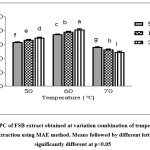 |
Figure 2: TPC of FSB extract obtained at variation combination of temperature and time of extraction using MAE method. |
Total Flavonoid (TF)
The total flavonoid of FSB extract obtained from the extraction using MAE, at different temperatures and duration of extraction combinations ranged from 40.67 to 70.30 mg QE/g. The highest flavonoid was obtained by extraction at 60°C for 25 min.
Figure 3 shows the highest TF obtained at a temperature of 60 °C for 25 min amounting to 70.30 mgQE/g. While the lowest TF value was obtained at a temperature treatment of 70°C with an extraction time of 25 min, amounting to 40.67 mgQE/g.
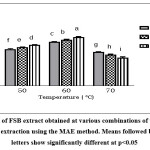 |
Figure 3: TF of FSB extract obtained at various combinations of temperature and time of extraction using the MAE method. |
Radical scavenging activity (DPPH)
The radical scavenging activity of the FSB extract ranged from 47.96 to 73.40% (Figure 4). There is an increase in the radical scavenging activity of FSB extract obtained from extraction at 50 to 60 °C. Extraction of FSB at 70 °C resulted in a lower radical scavenging activity.
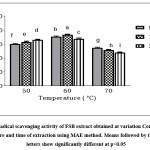 |
Figure 4: Radical scavenging activity of FSB extract obtained at variation combination of temperature and time of extraction using MAE method. |
Identification of bioactive compound in FSB extract
Figure 5 presents the chromatogram of the LC-HRMS analysis of FSB. The identified compounds are phenol, flavonoids, alkaloids, fatty acids, and their derivatives. Figure 6 presents several fragmentation patterns of compounds extracted from FSB. Some of the identified compounds were methyl cinnamate, vanillin, apocynin, scopoletin, L(-)-pipecolinic acid, arecoline, δ-valerolactam, 3,4-dihydroxybenzaldehyde, 4-hydroxybenzaldehyde. A group of flavonoids was epicatechin and rutin. Fatty acids and their derivatives were eicosapentaenoic acid 9-oxo-10,12-octadecadienoic acid, 2,4-dihydroxy-heptadec-16-en-1-yl acetate, pinolenic acid, oleamide, α-eleostearic acid, 12-oxo phytodienoic acid, α-linolenoyl ethanolamide, palmitic acid, oleyl anilide dan 1-linoleoyl glycerol. The full list of compounds is attached in the supporting material (Table S1). There are some compounds identified as the same compounds, but they have different retention times, e.g. L(-)-Pipecolinic acid (1.01 and 0.87 min), (-)-Epicatechin (5.44 and 5.60 min) and Scopoletin (0.85 and 6.87 min). It might be that those compounds are isomers. Further analysis is needed to confirm this.
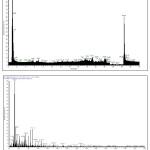 |
Figure 5: LC-HRMS chromatogram of FSB extract |
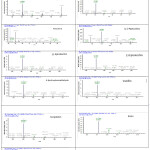 |
Figure 6: LC-HRMS fragmentation patterns of some compounds extracted from FSB |
Discussion
The yield of TPC and TF increased as the extraction temperature rose from 50 to 60 °C. Extraction at 70 °C resulted in a lower product of TPC and TF. At temperatures up to 60 °C, the heat from microwave energy can improve mass transfer, a better diffusion rate, and reduce viscosity and surface tension, resulting in higher yields of flavonoids.16 Irradiation of microwave speeds up cell rupture by rapidly increasing temperature and internal pressure inside the cells as a booster for the destruction of the sample surface. It turns the release of the target compounds to the surrounding solvent.17 Energy generated from the heat and microwave interact with polar solvent and allows the solvent to enter the matrix of plants resulting in more extracted bioactive compounds.18 However, extraction time had a very low negative significant impact on the TF of citrus peel extraction, indicating that increasing extraction time could decrease the TF slightly. 19 Temperature gave a positive effect up to 60 °C meaning that increasing the extraction temperature resulted in a good impact on radical scavenging activity, which was in line with the increase of TF and TPC as the extraction temperature was higher. The longer the duration of extraction and temperature would increase the degradation of some heat-labile antioxidative compounds.
There is an increase in the antioxidant activity of FSB extract obtained from extraction at 50 to 60 °C. Extraction at 70 °C resulted in lower antioxidant activity. The microwave energy causes plant tissue degradation, cellulose dehydration, and weakening of the microstructure. Therefore, the solvent penetrates easily into the cellular channels to release the solute into the solvent12. At higher temperatures, the MAE will destroy the cell matrix’s cell wall and the cells’ solute can be released into the surrounding solvent.20,21 In this study, the increase in the total phenol can be accredited to the heating effect. An increasing the solvent temperature was caused by the dipole rotation of the solvent in the microwave field, which was furthermore increasing the phenolic compounds’ solubility. The combination of temperature and time could increase the solubility of phenolic compounds and lower the solvent’s viscosity, therefore, accelerating the release and dissolution of these compounds. However, degradation of the phenolic compounds can occur at a higher temperature22. A lower extraction temperature may produce a more stable extract but may result in a lower extraction yield. The heat stability of a plant during extraction refers to its ability to retain its chemical and physical when subjected to high temperatures during extraction. The temperature significantly affected the extraction of flavonoids from citrus peel. Until 75 °C, the yield of flavonoids still increased, indicating that the extraction at 75 °C has not shown degradation of the flavonoids19.
Conclusion
This research showed an interaction between temperature and time of microwave-assisted extraction of FSB on TPC, TFC, and radical scavenging activity. The yield of TPC and TF has been higher as the rising temperature from 50 to 60 °C. Extraction at 70 °C decreased the yield TPC and TF. The newly identified specific phenolics and flavonoids were successfully profiled. Future research for testing the biological activity of the extract or the newly identified of phenol or flavonoid is necessary to study.
Acknowledgment
The authors sincerely thank Midia Lestari Wahyu Handayani (Laboratory of Life Sciences Universitas Brawijaya Indonesia) for assisting the HRMS analysis.
Conflict of interest
The authors have no conflicts of interest to declare.
Funding Sources
This research received funding from The Ministry of Education, Culture, Research, and Technology Directorate General Higher Education Research and Technology Research through the Research of Thesis Magister 2022 with the contract number: 1071.20/UN10.C10/TU/2022.
References
- Siswadi S., Rianawati H., Saragih G., Hadi D.S. The potency of faloak’s (Sterculia quadrifida, r.br.) active compounds natural remedy. 2018. Prosiding International Seminar Forests & Medicinal Plants for Better Human Welfare.
- Safdar M.N., Kausar T., Jabbar S., Mumtaz A., Ahad K., Saddozai A.A.. Extraction and quantification of polyphenols from kinnow (Citrus reticulate L.) peel using ultrasound and maceration techniques. J Food Drug Anal. 2017; 25(3):488-500.
CrossRef - M’hiri N., Ioannou I., Ghoul M., Boudhrioua N.M. Extraction Methods of Citrus Peel Phenolic Compounds. Food Rev. Int. 2014 ;30 (4): 265-290.
CrossRef - Naczk, F. Shahidi, Extraction and analysis of phenolics in food. Journal of Chromatography A. 2004; 516: 1054 95-111.
CrossRef - Chaves J.O., de Souza M.C., da Silva L.C., Lachos-Perez D., Torres-Mayanga P.C., Machado ApdF., Forster-Carneiro T., Vázquez-Espinosa M., González-de-Peredo A.V., Barbero G.F., Rostagno M. Extraction of flavonoids from natural sources using modern techniques. Frontiers in chemistry. 2020; 8:507887-507887.
CrossRef - Terigar B.G., Balasubramanian S., Boldor D., Xu Z., Lima M., Sabliov CM. Continuous microwave-assisted isoflavone extraction system: Design and performance evaluation. Bioresour Technol. 2010;101:2466-2471.
CrossRef - Inoue T., Tsubaki S., Ogawa K., Onishi K., Azuma J. Isolation of hesperidin from peels of thinned Citrus unshiu fruits by microwave-assisted extraction. Food Chem. 2010; 123 (2): 542-547
CrossRef - Ahmad J., Langrish T.A.G., Optimisation of total phenolic acids extraction from mandarin peels using microwave energy: The importance of the Maillard reaction. Food Eng. 2012; 109 (1): 162-174.
CrossRef - Hayat K., Hussain S., Abbas S., Farooq U., Ding B., Xia S., Jia C., Zhang X., Xia W. Optimized microwave-assisted extraction of phenolic acids from citrus mandarin peels and evaluation of antioxidant activity in vitro. Sep Purif Technol. 2009;70:63-70.
CrossRef - Lapornik B., Prošek M., Golc Wondra A. Comparison of extracts prepared from plant by-products using different solvents and extraction time. J Food Eng. 2005;71:214-222.
CrossRef - Yuan Y., Macquarrie D., Microwave assisted extraction of sulfated polysaccharides (fucoidan) from Ascophyllum nodosum and its antioxidant activity. Polym. 2015; 129: 101-107.
CrossRef - Mandal, V., Mohan, Y., Hemalatha, S. Microwave Assisted Extraction-An Innovative and Promising Extraction Tool for Medicinal Plant Research. Pharmacognosy Reviews. 2007;1 (1):7-18.
- Mendes M., Carvalho A.P., Magalhães J.M.C.S., Moreira M., Guido L., Gomes A.M., Delerue-Matos C. Response surface evaluation of microwave-assisted extraction conditions for Lycium barbarum bioactive compounds. Innovative Food Science & Emerging Technologies. 2016;33:319-326.
CrossRef - Martati E., Simamora GM. Physico-chemical characteristics of ethanolic extract of onion peel (Allium ascalonicum l.) extracted using microwave-assisted extraction. Jurnal Aplikasi Teknologi Pangan 2021;10 (2): 39-45.
CrossRef - Martati E., Ciptadi P. Extraction of baby java citrus (Citrus sinensis (L) Osbeck) peel by microwave-assisted extraction. IOP Conference Series: Earth and Environmental Science 2020;443:012020.
CrossRef - Almusallam I.A., Mohamed Ahmed I.A., Babiker E.E., Al Juhaimi F.Y., Fadimu G.J, Osman M.A., Al Maiman S.A., Ghafoor K., Alqah H.A. Optimization of ultrasound-assisted extraction of bioactive properties from date palm (phoenix dactylifera l.) spikelets using response surface methodology. LWT 2021;140:110816.
CrossRef - Zhang B., Yang R., Liu C.Z., Microwave-assisted extraction of chlorogenic acid from flower buds of Lonicera japonica Thunb. Purif. Technol. 2008, 62 (2): 480-483.
CrossRef - Xiao W, Han L, Shi B. Optimization of Microwave‐Assisted Extraction of Flavonoid from Radix Astragali using Response Surface Methodology. Sep Sci Technol. 2008;43(3):671-681.
CrossRef - Martati E, Utari P.D, Wulan N. Modelling the Influence of Extraction Parameters on the Recovery of Antioxidant Compounds of Microwave Extracted Citrus (Citrus Reticulata) Peel by Response Surface Methodology. Current Analytical Chemistry. 2022;18:1-1.
CrossRef - Chemat , Zill-e-Huma, Khan M.K. Applications of ultrasound in food technology: Processing,preservation and extraction. Ultrasonics Sonochemistry. 2011; 18: 813–835.
CrossRef - Rombaut N., Tixier A.S., Bily A., Chemat F. Green extraction processes of natural products as tools for biorefinery. Biofuels, Bioproducts and Biorefining; 2014:8:530-544.
CrossRef - Dahmoune F, Nayak B, Moussi K, Remini H, Madani K. Optimization of microwave-assisted extraction of polyphenols from Myrtus communis Leaves. Food Chem; 2015;166:585-595.
CrossRef

This work is licensed under a Creative Commons Attribution 4.0 International License.

